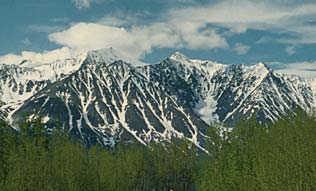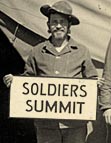
Unofficial views: amateur photographers and filmmakers in the Northwest
U.S. Army 18th Engineers building Slim’s River Bridge using a pile driver. A pontoon bridge is seen to the right. August 1942. (view more details)
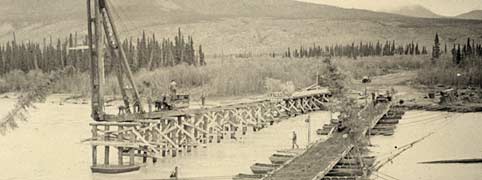
There are many still and moving images that document the construction of the Alaska Highway and the Canol project. Some of these are photographs and films created under orders or sanction from the U.S. Army. Other images were taken by men and women working on the highway or on the Canol projects who did not have official status. While the purposes and audiences of the official and unofficial views differed, the images are remarkably similar, featuring shots of equipment, methods of road construction, trucks stuck in mud, views of the camps and refineries, and, most notably, the men and women (although, in the case of official photographs, mostly men) who worked on the roads and pipelines.
The official images were documentary, created in the interests of the U.S. Army as visual evidence that the Alaska Highway and Canol project were unprecedented military and engineering accomplishments of a vast scale, built by strong and stoic men serving their country. They were created in part to convince the American public of the projects’ value, and the photographers were directed to take photographs that would fulfill this purpose.
Richard Finnie was commissioned by Bechtel-Price-Callahan as an advisor and filmmaker on the Canol project. He subsequently wrote a book featuring his documentary photographs entitled Canol: the sub-Arctic Pipeline and Refinery Project constructed by Bechtel-Price-Callahan for the Corps of Engineers United States Army 1942-1944; the book was produced "in compliance with War Production Board regulations." Finnie’s work is typified by vast, empty landscapes, wide-angle shots of construction activities, and the odd candid image of men awaiting their mail or their meals.
William E. Griggs was the official photographer for the 97th Army Corps of Engineers, one of the black regiments that worked on the highway. In 2002, his photographic history of the regiment was published as The World War II Black Regiment That Built the Alaska Military Highway. Like Finnie, Griggs photographed camps and equipment, but he also took more close up, candid shots of men at work and at leisure: typing official correspondence, repairing tires, and playing music and cards. More so than Finnie, Griggs creates a more personal view of the men who worked on the Alaska Highway and Canol projects.
Two soldiers drilling a hole in a timber bridge... (view more details)
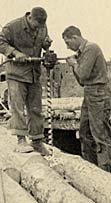
In the case of the "unofficial views," both the photographers’ objectives and their audience differed from the official perspective. Intended for a private rather than public audience, the photographs taken by the men and women who worked on the northern projects do tend to document more personal experiences such as friendships, dating, and office environments. At the same time, many of the photographs are "documentary" in character, capturing similar subjects to the official photographers, including vehicle mishaps, long shots of refineries, and men laying corduroy roads and building bridges.
outside a Nissan Hut door on Shemya Island. August 1944. ... (view more details)
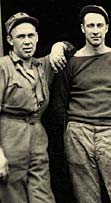
The similarities between official and unofficial views suggest that the men and women who worked on the highway and Canol projects were proud of the time they spent in the North, and were determined to make the most of the experience. Although there was certainly low morale among personnel, the images created by the workers demonstrate the difficulties, hardships and challenges without being openly critical of the projects themselves. While censorship was in effect during wartime and photographs could potentially be suppressed, it is doubtful that any of the images in the Yukon Archives collections would have required such action.
Voight in front of the beer parlor, Carcross, Yukon (view more details)
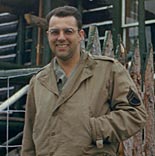
The "unofficial" photographers created images and sounds that document the highway and Canol projects from an unofficial point of view. Although mud, mosquitoes and cold temperatures emerge as adversaries, in general these unofficial recorders documented their northern experiences as memories worthy of preserving.
Pine Creek camp at Mile 1019 near Haines Junction. White canvas tents with snow-covered mountains in background. 1948 (view more details)
